

Display No. 4A
ROSS, John O’Connell
John Ross joined the Canterbury Division of the Royal Naval Volunteer Reserve (RNVR) in 1936 and was commissioned two years later.
At the outbreak of the Second World War, Ross was mobilised and undertook extended officer and anti-submarine training before being posted to HMS Wakakura as Executive Officer in 1941. In 1942 he took part in the Solomon Islands Campaign serving as a lieutenant in HMNZS Matai. In 1944 he was sent to the United Kingdom for advanced training, before returning to New Zealand in 1946 as a gunnery specialist and being offered a permanent commission in the Royal New Zealand Navy that year.
During the Korean War, Ross served in HMNZS Tutira. He subsequently served as Executive Officer in HMNZ Ships Black Prince, Bellona, and Royalist. He also served on exchange with the Royal Navy, including attending the Imperial Defence College. Serving three years as Naval Attaché in London, he then became Commodore Auckland. From 1965 he was Chief of Naval Staff and First Member of the New Zealand Naval Board until his retirement from the Navy in 1969.
John Ross is the son of Murdoch Ross, whose medals are also on display here.
Awarded medal(s)
Medal Description [Left to Right]:
Companion of the Most Honourable Order of the Bath (CB)
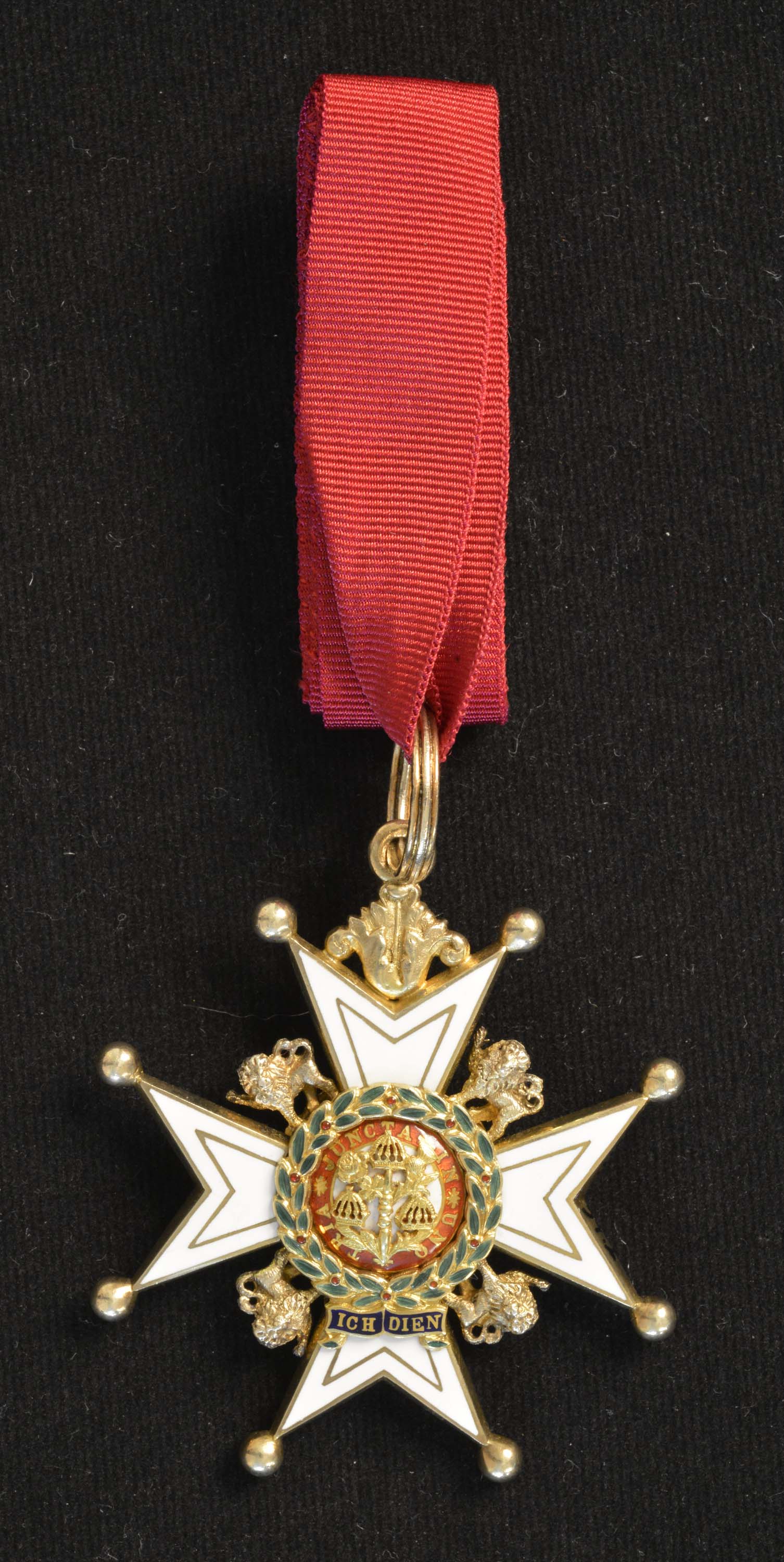
British order of chivalry with three classes of members: Knight and Dame Grand Cross (GCB), Knight and Dame Commander (KCB and DCB) and Companion (CB). It was awarded to military personnel during both World Wars. Recipients of the order are usually senior military officers or senior civil servants. The ribbon is crimson red.
Commander of the Most Excellent Order of the British Empire (CBE)
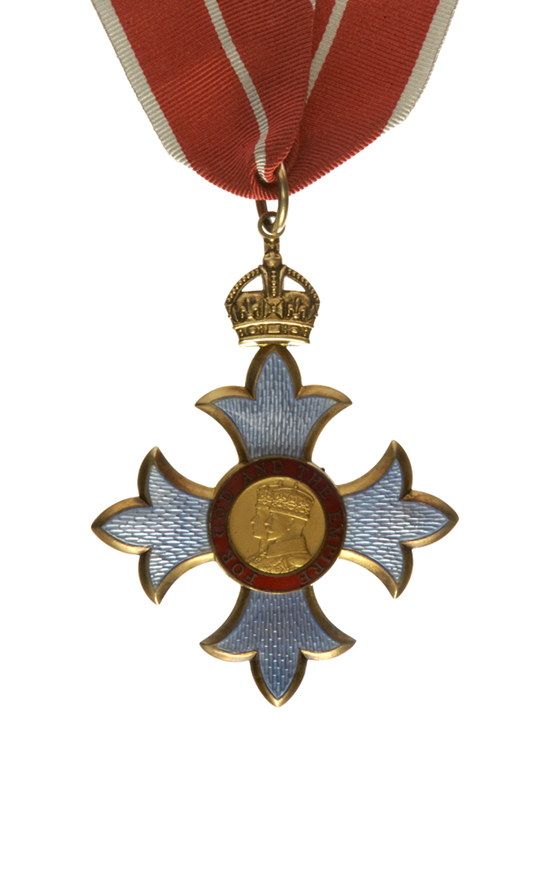
Established by King George V in 1917 for services to the British Empire. The Order has five classes: Knight and Dame Grand Cross (GBE), Knight Commander and Dame Commander (KBE / DBE), Commander (CBE), Officer (OBE) and Member (MBE). The KBE, DBE and CBE badge is silver-gilt with the arms enamelled pearl-grey and a crimson enamelled circle. In December 1918, the Order was split into two divisions: a Civil Division for civilian recipients; and a Military Division for awards to commissioned officers and warrant officers for distinguished service in action. The insignia of the Civil and Military Divisions is distinguished only by the ribbon, the military award having a narrow central stripe. Prior to the introduction of the New Zealand Order of Merit in 1996, the Order of the British Empire was the most common honour awarded to New Zealand military personnel.
The 1939-1945 Star
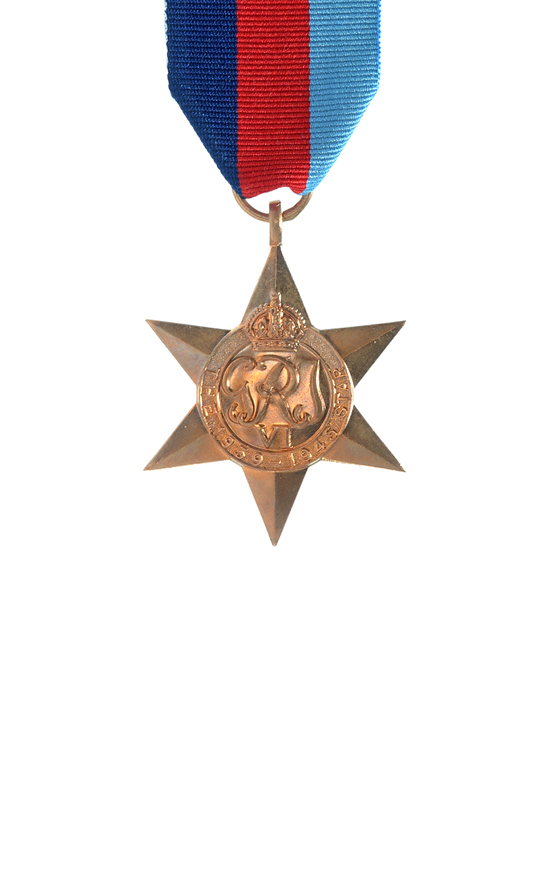
The 1939-45 Star is the first in a series of eight campaign stars instituted in 1945 to recognise service in World War Two. The ribbon has three equal vertical stripes of dark blue, red and light blue. The dark blue stripe symbolises the service of the Navy and the Merchant Navy, the red stripe symbolises the service of the Army, and the light blue stripe symbolises the service of the Air Force. The equal width bands represent the equal contributions of the three service arms towards victory. The ribbon was devised by King George VI. Two clasps could be awarded with this medal: ‘Battle of Britain’ and ‘Bomber Command’. Only aircrew would qualify for these clasps although a small number of Fleet Air Arm naval pilots flew for the air force and would be eligible for the ‘Battle of Britain’ clasp.
The Atlantic Star
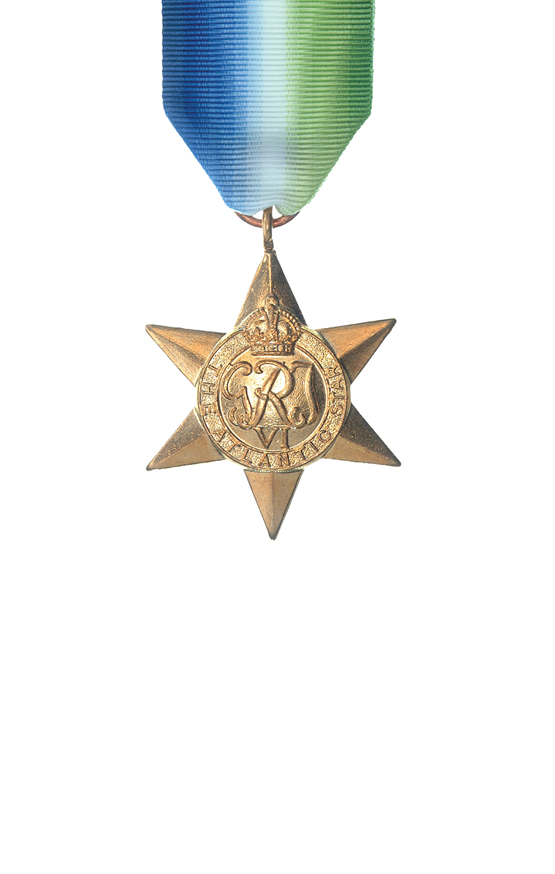
The Atlantic Star was awarded for service during the Second World War. It was instituted to commemorate the Battle of the Atlantic the longest continuous military campaign in the Second World War running from 3 September, 1939 – 8 May, 1945. Six months naval service or four months air service in the Atlantic, United Kingdom (‘home’) waters or North Russian waters was normally required. The ribbon is watered silk coloured blue, white and green, symbolising service in the oceans. Two clasps could be awarded with this medal: ‘France and Germany’ and ‘Air Crew Europe’. Personnel issued the Atlantic Star who then qualified for either the France and Germany and the Air Crew Europe Stars were awarded a clasp in respect of the second only (as only one clasp could be worn on the star).
The Pacific Star
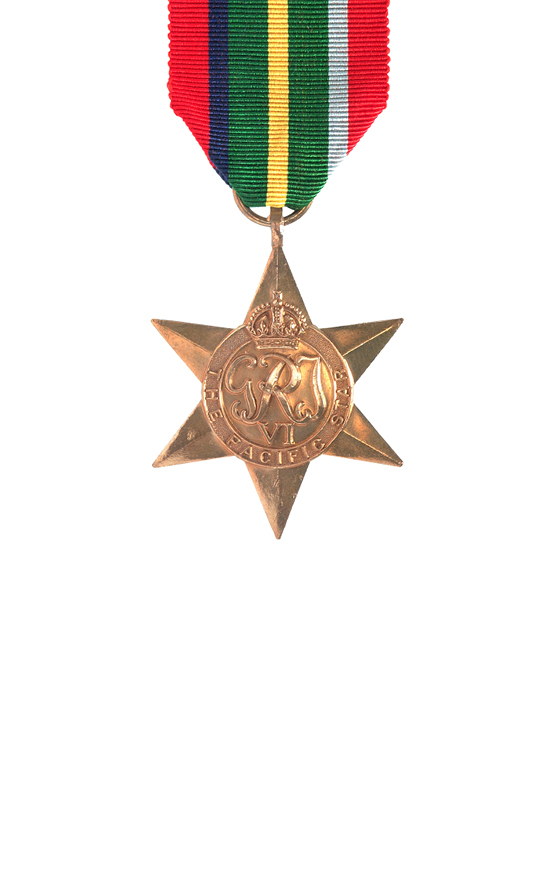
The Pacific Star was awarded in the Second World War for operational service in the Pacific between 8 December 1941 and 2 September 1945. This medal was also awarded for certain specified service in China, Hong Kong, Malaya and Sumatra: between 8 December 1941 and 25 December 1941 (for Hong Kong); between 8 December 1941 and 15 February 1942 (for China and Malaya); and between 8 December 1941 and 23 March 1942 (for Sumatra). The centre of the ribbon is dark green (symbolising the jungle) with a central yellow stripe (symbolising the beaches). On the outer edges are wide stripes of red (representing the Army), with narrow stripes of dark blue and light blue (representing the Navy and Air Force) between the stripes of dark green and red. A ‘Burma’ clasp could be awarded with this medal. Personnel qualifying for both the Pacific and Burma Stars were awarded the first star but only a clasp in respect of the second.
The Defence Medal
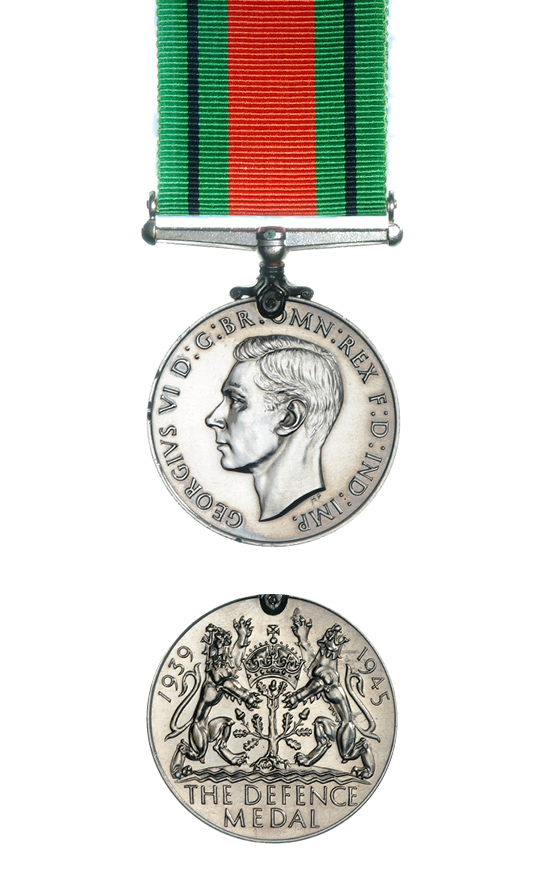
The Defence Medal was awarded to British and Commonwealth forces who served during the Second World War. It was awarded to New Zealand military personnel who served overseas in a non-operational area such as Great Britain, Palestine or Fiji. The ribbon’s flame-coloured orange centre band and green edge bands symbolise enemy attacks on Britain’s green and pleasant land. The narrow black stripes represent the black-outs against enemy air-attacks.
The War Medal 1939-1945

The War Medal 1939-45 was awarded across the British Commonwealth to all full-time members of the Armed Forces in the Second World War for 28 days service between 3 September 1939 and 2 September 1945, irrespective of where they were serving. The ribbon is the red, white, and blue of the (British) Union Flag. There is a narrow central red stripe with a narrow white stripe on either side. There are broad red stripes at either edge, the two intervening stripes being blue.
A bronze oak leaf on the medal ribbon denotes that the recipient was Mentioned in Despatches. To be Mentioned in Despatches a member of the armed forces had their name mentioned in an official report, written by a superior officer, and sent to a higher command. The report would describe the individual’s gallant or meritorious action in the face of the enemy.
The New Zealand War Service Medal
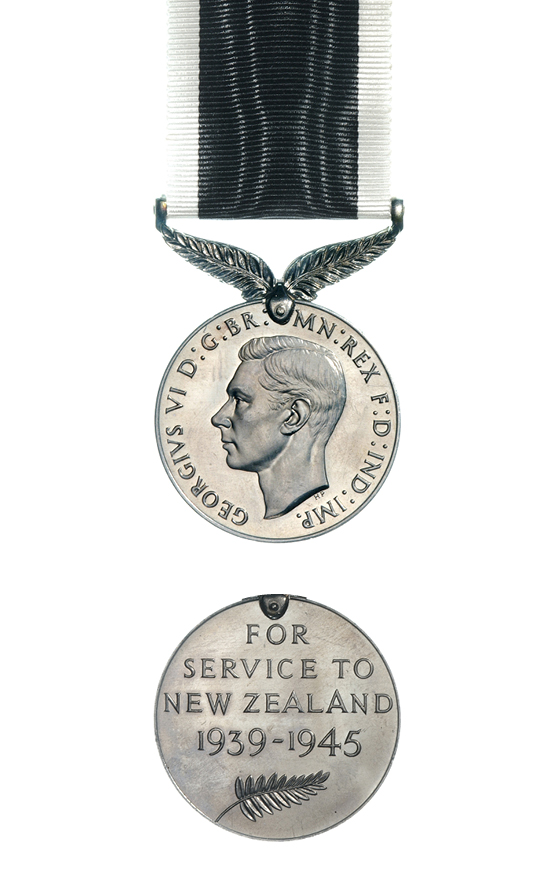
The New Zealand War Service Medal was awarded for 28 days’ full time service or six months’ part time service in the Second World War in any of the New Zealand Armed Forces including the Reserves, Naval Auxiliary Patrol Service, or Home Guard, between 3 September 1939 and 2 September 1945.
The Korea Medal

This medal was instituted in 1951, to recognise the service of Commonwealth troops in the Korean War between 2 July 1950 and 27 July 1953. It is sometimes referred to as the Queen’s Korea Medal to differentiate it from the United Nations Korea Medal. For naval forces, qualification is 28 days or more afloat in the operational area or at least one day of shore duty. The medal’s reverse features Hercules wrestling the Hydra – a symbolic representation of communism. The ribbon has alternating yellow and blue stripes. Blue represents the United Nations.
United Nations Medal Korea
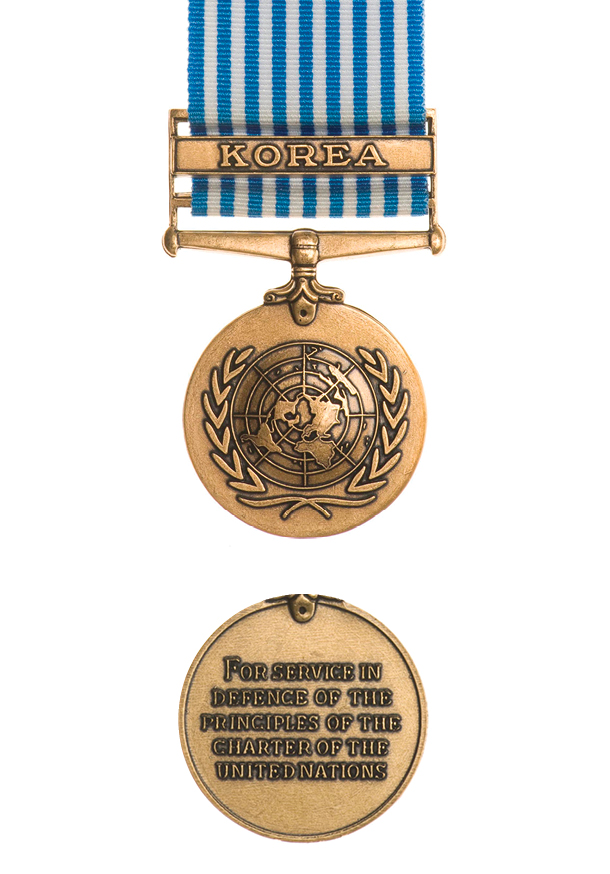
The United Nations Medal (Korea) was awarded for service during the Korean War and the year following the armistice (July 1950 to July 1954). It was the first international award created by the United Nations and features the UN emblem of a projection map of the world between two olive branches. The medal recognises the service of all military troops participating as part of the UN forces in Korea and was manufactured in the language of each country. It was also awarded to a limited range of civilians whose organisations were certified by the United Nations Commander-in-Chief as having directly supported military operations in Korea between 1950 and 1954.
The General Service Medal 1962
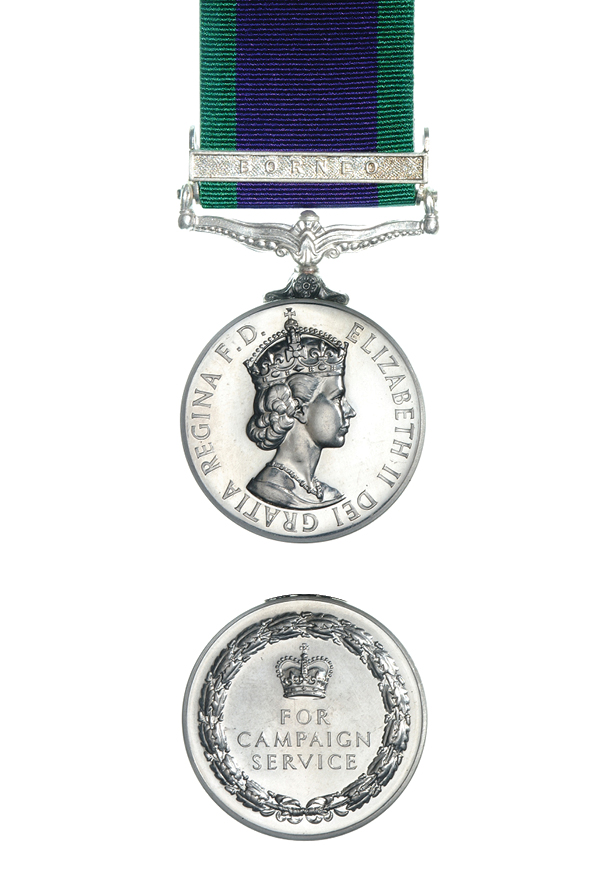
The General Service Medal 1962 was instituted in 1964 (replacing both the Naval General Service Medal 1915-1962 and General Service Medal 1918-1962) to recognise service in minor operations for which no separate medal was intended. This medal was always awarded with a clasp for the specific area of operation. A total of 14 clasps have been issued but only two have been awarded to New Zealanders in significant numbers. These are the ‘Borneo’ and ‘Malaya Peninsula’ clasps awarded for service related to the Indonesian Confrontation of the 1960s.
Galathea Medal 1955
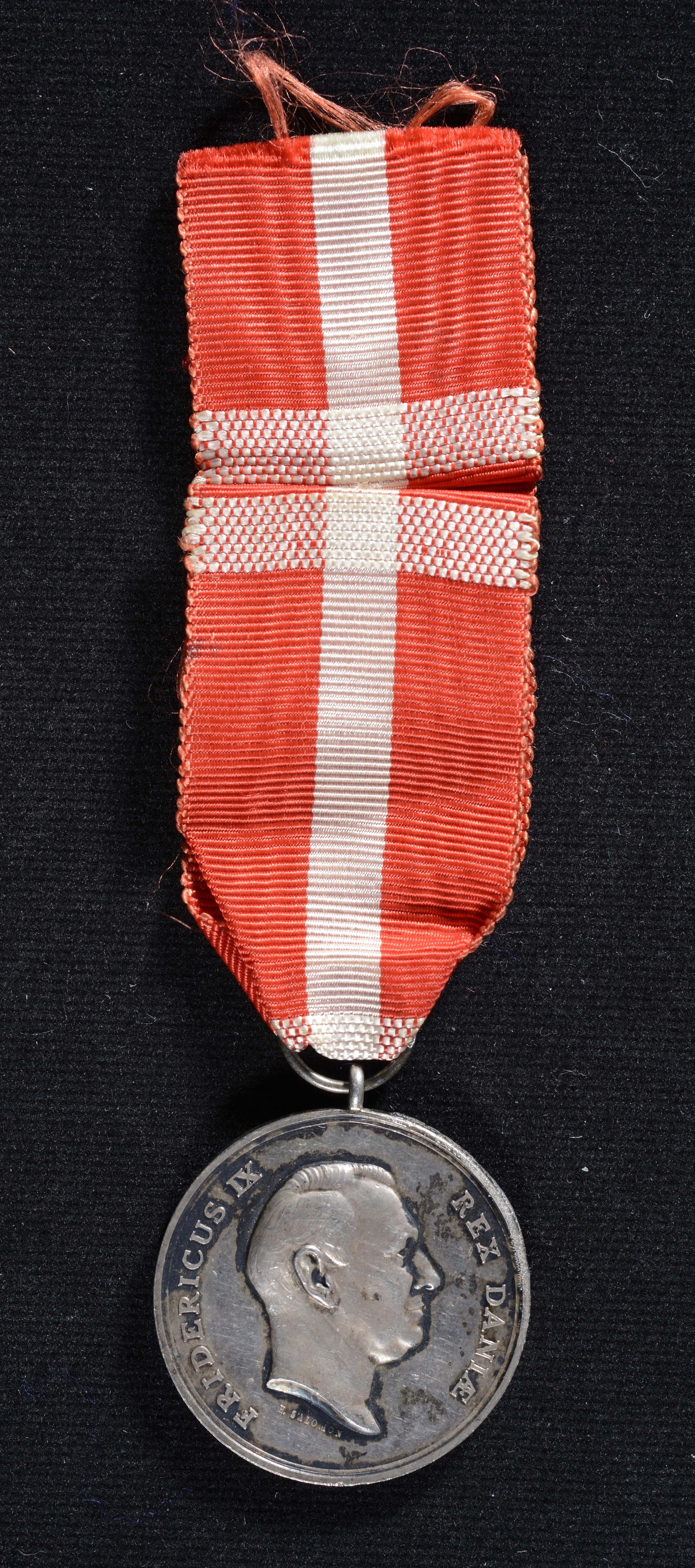
A Danish military medal awarded to recognise individuals who assisted in creating, and participated in the Scientific Danish Deep Sea Expedition between September 1, 1950 and July 17, 1952. Individuals who did not participate in the expedition were also able to receive this award if they supported it in exceptional ways.
Special interest medal(s)
Display No. 26D
Handmade Medal
Handmade medal for the ‘Battle of the Glorious First of June.’ The medals were awarded to the crew of HMNZS Pukaki for a night encounter in the Indonesian Archipelago in 1955. The presentation took place in HMNZS Bellona at the Singapore Naval base.


